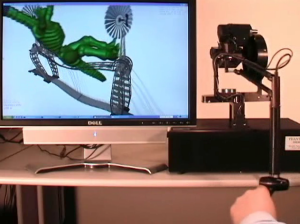6-DOF Haptic Demo (executables!)
Jernej Barbič
(Carnegie Mellon University),
Doug L. James
(Cornell University):
Time-critical distributed contact for 6-DoF haptic rendering of
adaptively sampled reduced deformable models

We are posting these demos so that other haptic researchers can try our results; it is sometimes difficult to evalute haptic results just by reading the paper. The demos run on force feedback devices manufactured by Sensable Technologies, under Windows XP. In particular, the demos were designed for the Phantom Premium 6-DOF 1.5 device. We were also able to run them with Phantom Premium 3-DOF 1.5, and with an Omni. The demos use OpenHaptics, a haptic API from Sensable Technologies.
Please see the demo instructions.
You need the following to run the demo:
- A haptic device: Phantom Premium 6DOF 1.5 (preferred; demo settings are optimized for this device), Phantom Premium 3DOF 1.5, Omni (we did not try other haptic devices).
- A dual-core (or more cores) PC running Windows XP (64-bit computers and/or Windows Vista were not tested).
- Phantom device drivers version 4.2 or newer. Please read the instructions above for how to obtain the drivers (they are free).
- OpenHaptics DLL (hd.dll). Here is why we cannot provide the DLL with our demo. Please read the instructions above for how to obtain the DLL. If your academic institution qualifies (many do), this process is easy.
- Core of the demo (zip; 1.7 Mb). Current version number is 1.6.
- One or more of the following demo data files:
- bridge and dinosaur (defo + rigid; zip; 101 Mb)
- bridge (finer pointshell) and dinosaur (defo + rigid; zip; 92 Mb) | REQUIRES: bridge and dinosaur
- dragon and Buddha (defo + rigid; 171 Mb)
- horse and dragon (defo + rigid; 168 Mb)
- knight and axe (rigid + rigid; 117 Mb; L6 pointshell with 1 million points on the knight)
- "alpha" path planning puzzle (rigid + rigid; zip; 3.7 Mb; alpha puzzle mesh (version 1.0) was obtained here. )
- hole and peg (rigid + rigid; zip; 1 Mb)
Installation: there is no specific installation utility. Simply unzip all the archives from the same folder: create an empty folder, copy all the zip files into that folder, then unzip from that folder. Appropriate subdirectory structures will be created automatically during unzip. This image demonstrates how your Windows demo folder should look like, assuming you have downloaded all the demos, and obtained the hd.dll. It is important to let your unzip utility create the directory structure stored within the zip archive; this is typically enabled by default, but not always. Also, the built-in Windows unzip utility adds an extra directory level whenever you unzip an archive; you should remove this extra directory level if you are using the built-in Windows unzip utility. Please read the instructions for more information.
Related publications: Please see the main project page for all the other project-related information.Comments, questions to Jernej Barbič.
Copyright notice
The demos contained in these directories are included by the contributing authors as a means to ensure timely dissemination of scholarly and technical work on a non-commercial basis. Copyright and all rights therein are maintained by the authors or by other copyright holders, notwithstanding that they have offered their works here electronically. It is understood that all persons copying this information or using the demos will adhere to the terms and constraints invoked by each author's copyright. These works may not be reposted without the explicit permission of the copyright holder.
